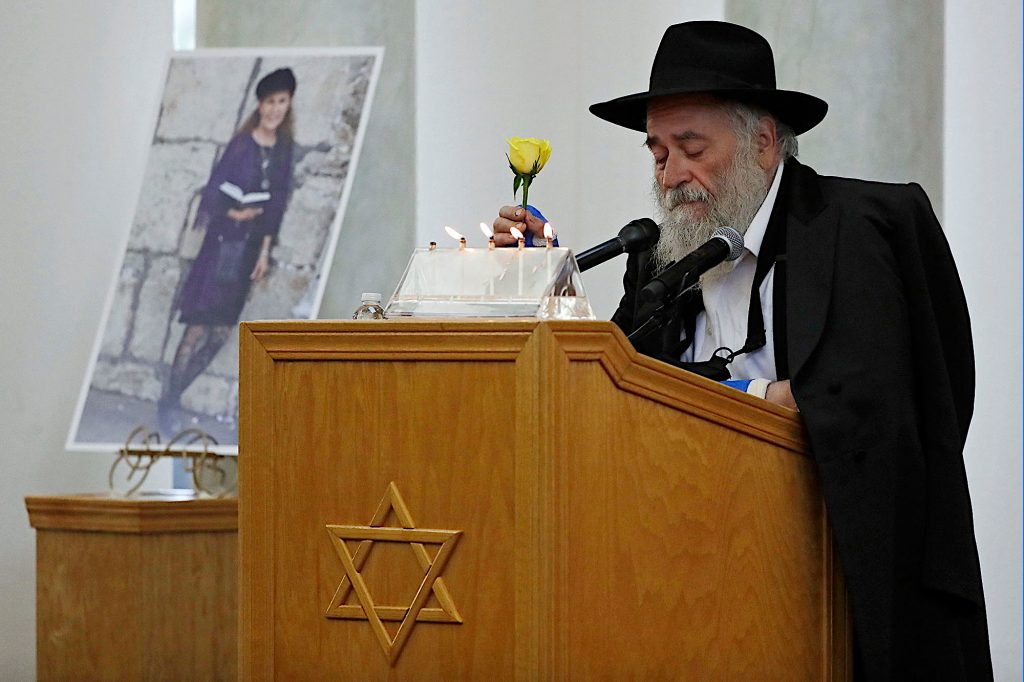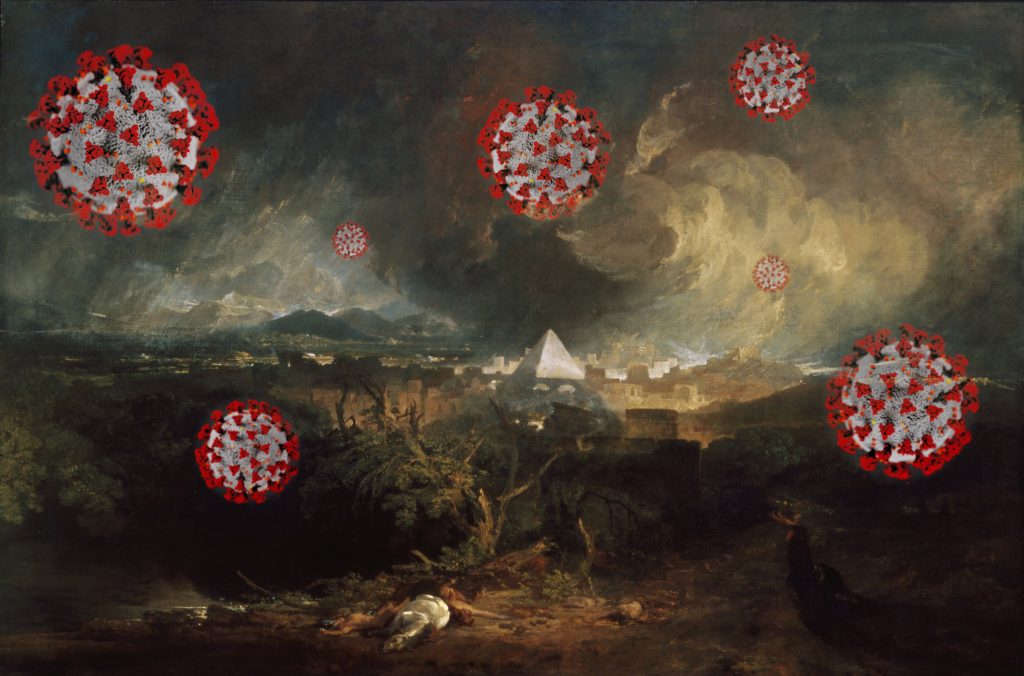(7-8 Minute Read)
As we approach the final days of the Passover holiday, we also near the one year anniversary of one of the most shocking and appalling acts of hatred inflicted upon the American Jewish world in modern history: the Poway synagogue shooting.
On April 27th, 2019, as the eight-day Jewish festival of Passover came to a close, a relatively small Jewish community of worshippers came together on a seemingly idyllic morning in southern California. Jewish congregants from a variety of backgrounds milled into the Chabad synagogue under the leadership of Rabbi Yisroel Goldstein. Among those congregants was a sixty year-old Jewish woman named Lori (Leah) Gilbert-Kaye, one of the founding members of the community. She and her husband had helped build the local community (quite literally), and were instrumental in the construction of the Chabad of Poway synagogue building. She was described as a kind-hearted philanthropist. The entire congregation raved of the Shabbat meals and Yom Kippur break-the-fast spread provided by Lori and her family week after week and year after year. Warmth and hospitality were signature graces of this true eishet chayil, or woman of valor.
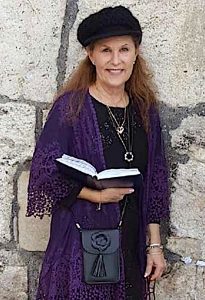
Lori Gilbert-Kaye stepped out of the morning prayer service on this final day of Passover which also overlapped with Shabbat. She moved into the foyer to check on the children’s program, bustling with energetic and enthusiastic little people who are often notoriously a bit noisy.
“Rabbi Goldstein,” Lori called out quietly to the Chabad synagogue leader as he drew near a sink to ceremonially wash his hands in preparation to read the Haftarah, a portion taken from the Biblical prophets, aloud in the synagogue. “What time is yizkor?”
It was an emotional time for Lori. Tragically, her mother had passed away not long before. On certain festivals, it is customary to recite yizkor, a set of memorial prayers in honor of close family members who have unfortunately left us, during the morning service.
“Yizkor services will be held at 11:30 this morning,” Rabbi Yisroel Goldstein replied. He understood with deep sympathy that this was a difficult yet important moment for Lori. Rabbi Goldstein turned away and prepared to wash his hands at a small external sink.
The doors of the synagogue opened. A young man walked in at 11:23 a.m., just seven minutes before the estimated commencement of the yizkor memorial prayer for deceased loved ones. His name was John Timothy Earnest. His dark eyes matched his short, wavy, equally dark hair. He appeared no different than any other Caucausian young person with one unmistakable exception. His glaring eyes brimmed with hatred as he tightly clutched a loaded rifle.

Lori stood face-to-face with the armed attacker. In that moment she couldn’t have realized the irony that the young man who now prepared to kill her and as many Jewish worshippers as possible was actually a nineteen year-old college student who had previously dedicated his life to helping others and saving lives through the profession of nursing. John Timothy Earnest gazed upon her and other members of the community. He raised the rifle and fired the weapon. Some reports claimed that Lori tried to throw herself between the armed attacker and Rabbi Yisroel Goldstein, but these accounts can be somewhat convoluted. Regardless, there is no question that Lori Gilbert-Kaye, the virtuous woman and feminine pillar of the local Jewish community, had been shot in cold blood and now lay bleeding on the floor of the synagogue.
Rabbi Goldstein heard the loud banging sound of the gunshots, but he did not immediately understand what had happened. Had a table collapsed? Had Lori fallen and possibly injured herself? Rabbi Goldstein returned to the foyer where he and Lori Gilbert-Kaye had been chatting just a few short moments prior.
John Earnest turned his focus towards Rabbi Yisroel Goldstein. Rabbi Goldstein instinctively raised his hands to futilely protect his face as the gunman aimed the rifle at the congregational leader. John again pulled the trigger repeatedly, hurling bullets towards Yisroel Goldstein’s head. Several bullets tore into the hands and fingers of the rabbi, the same hands and fingers that presumably were still dripping with the purifying waters of netilat yadayim, the ceremonial hand washing.
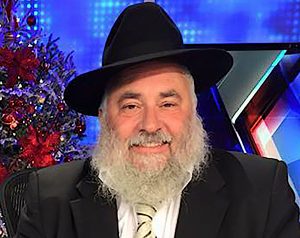
The gunman continued his shooting spree. Rabbi Goldstein and a visiting guest from Israel, Almog Peretz, frantically attempted to herd the children to safety away from the killer. In the process Earnest pointed his rifle at Almog Peretz as well as his eight year-old niece, Noya Dahan, mercilessly shooting and wounding both of them.
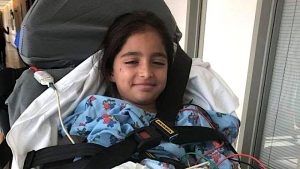
Meanwhile, Oscar Stewart, an unarmed US Marine veteran, charged the attacker. At some point, John’s rifle jammed or malfunctioned. The assailant turned and fled, and Jonathan Morales, an off-duty Border Patrol agent with a personal firearm, pursued him as he drove off.
Rabbi Yisroel Goldstein clutched a tallit, or prayer shawl with traditional fringes, and wrapped his bleeding hands and fingers. Dark, reddish-brown blood oozed into the woolen fabric, permanently staining the pure white garment lined with black stripes. The rabbi returned to the foyer, the original location of the carnage. Lori Gilbert-Kaye lay on the cold floor, bleeding and nearly lifeless. Her husband, Dr. Howard (Hershel Nochum) Kaye, had found her. He had already fainted and collapsed next to his wife in shock and immeasurable grief as he attempted to perform CPR on her. Not long after, Lori’s only daughter, Hannah, stumbled upon both of her parents lying on the floor, her mother dead and her father traumatized. Just a mere few minutes before Lori’s first opportunity to pray yizkor in memorial of her deceased mother, the neshama, or soul, of Lori Gilbert-Kaye joined her mother in the afterlife.
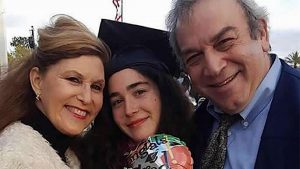
John Timothy Earnest soon turned himself in and was immediately apprehended by local law enforcement authorities. He was charged and prosecuted with multiple counts of murder and attempted murder. Earnest had declared via online forums that his motivation for the heinous attack was mostly linked to anti-Semitism and white supremacist ideology.
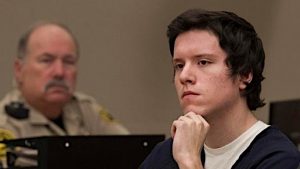
Almog Peretz and Noya Dahan both recovered of their wounds. In one of the more darkly ironic details of this tragedy, the Peretz family had previously lived in Sderot, Israel. Sderot faces a frequent barrage of Qassam rockets and other missiles launched by Hamas and other terrorist entities in the Gaza Strip solely intended to kill Israeli civilians. Three of the Peretz family siblings had come to the United States in an attempt to find a place to build Jewish homes and raise their families without the threat of terrorism. However, the Peretz siblings and their families ultimately found themselves to be the victims of violent hatred rivaling or even surpassing the rockets of Hamas and Palestinian Arab terrorists.
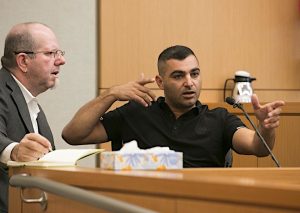
Rabbi Yisroel Goldstein survived, but he suffered permanent damage to his fingers and hands. Seven months after the Poway attack, Rabbi Goldstein retired from his position as community leader.
Immediately after the terrorist attack by John Timothy Earnest, the shocked and horrified community gathered just outside the synagogue, waiting for the ambulances to arrive. Rabbi Goldstein, shaken and bloody, addressed his community.
“In every generation they rise against us to destroy us; and the Holy One, blessed be He, saves us from their hand,” Rabbi Goldstein declared, citing a portion of the Haggadah of the Pesach seder, or the traditional liturgy of the ceremonial Passover dinner. He then raised his voice and shouted, “Am Yisrael Chai! The Jewish people live!” The rabbi later recounted that he had said that line hundreds of times in his life. But he never felt the truth of it more than he did in that moment.
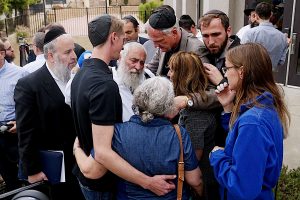
The holiday of Pesach, or Passover, recounts the story of the exodus from Egypt, beginning with the ten plagues and ending with the splitting of the Sea of Reeds (i.e. the Red Sea) and the drowning of Pharaoh and the Egyptian military. Immediately after the splitting of the sea, the surrounding nations were completely terrified of the G-d of the Jewish people (e.g. Joshua 2:9-11).
Well, every nation but one was filled with fear of the Almighty, that is. The one exception was Amalek. Despite the news of the ten plagues and the splitting of the sea, Amalek immediately armed themselves and attacked the early Jewish nation without any warning or provocation (Shemot / Exodus 17 and Devarim / Deuteronomy 25). Their attack was particularly underhanded, focusing on the weak, the elderly, and the children in the rear.
Our rabbinical sages have noted that the Biblical phrase of Devarim / Deuteronomy 25:28 “How [Amalek] happened upon you on the road” [“asher karcha b’derekh”] can have an alternate meaning. The Hebrew word karcha can be translated as both “happened upon you” and also as “cooled you off.” Our rabbis therefore taught that the Hebrew text hints that the purpose of Amalek attacking the Jewish people, and especially assaulting the weaker population in the back, immediately after the ten plagues and the splitting of the sea, was primarily an attempt to demoralize the Hebrew nation both spiritually and emotionally. As such, it could even be theorized that this demoralizing act of attacking weak and innocent people was potentially the first act of “terrorism” recorded in known human history.
Rabbi Yisroel Goldstein reminded his congregation in the face of unspeakable tragedy that “in every generation, they arise to kill us,” especially the descendants of Amalek, whether physical or spiritual. But no matter how much a literal or figurative “Amalek” tries to wipe out the Jewish people, Am Yisrael Chai! The Jewish people live!
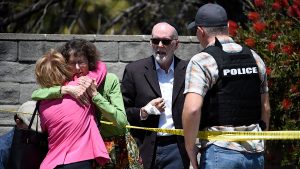
Sometimes “Amalek” comes in the form of a literal enemy, such as an ancient tribe of early “terrorists” seeking to kill as many Jews as possible. Sometimes “Amalek” is a more abstract foe, something that actively diminishes our fiery passion to seek after G-d, enhancing our connection to the Almighty through the Torah (Bible). And in some cases the physical and the spiritual “Amalek” meet in a single entity, such as the white supremacist gunman, John Timothy Earnest, who attempted to murder as many Jews as possible, and then called the police and calmly waited for them to arrest him. Earnest’s goal was both to kill Jews and to “cool off” the rest of the Jewish people, attempting to make us fearful and disheartened during Passover, the festival of our freedom.
How can we as the Jewish people fight back against the effects of “Amalek,” especially when our opponent is more abstract? How can we wage a war against this “cooling off,” the devious strategy of the arch-enemy of the Jewish people?
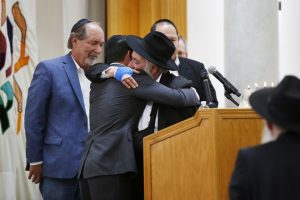
The reactions to the shooting of the Chabad synagogue of Poway were numerous. Some discussed the potential merits of qualified security personnel inside our synagogues. Others postulated gun control measures and their alleged effectiveness. Some engaged in political dialogue, posturing, and blame-shifting. Others became intimidated, fearful that they would become victims to a future attack. However, the Chabad movement responded with the best method to mitigate the “cooling effect” of an attack by “Amalek.” A widespread campaign was launched to perform mitzvot, good deeds and acts of kindness, as well as Torah study, in honor of Lori Gilbert-Kaye and in an effort to offset the “cooling off” that rippled throughout the entire Jewish world from the tragedy in Poway. When “Amalek” tries to “cool us off,” the ultimate response is to reignite our fire of passionately serving the Holy One, Blessed Be He, and connecting to Him and others through Torah study and kind deeds. From a spiritual perspective, a terrible tragedy can be used to ultimately benefit the Jewish people and our communities spiritually (not to diminish the grief and horror of that tragedy). And from a physical perspective, future would-be “Amalekites” could potentially be deterred from further attacks, seeing that striking the Jewish people only serves to unite us and make us stronger as we all declare in unison with Rabbi Yisroel Goldstein and the victims of Poway, “Am Yisrael Chai!” “The Jewish people live!” As the first anniversary of the Poway synagogue attack approaches, perhaps we can all, regardless of our synagogue affiliation or nusach, or traditional rite, come together in memorial of Lori Gilbert-Kaye and perform acts of kindness and engage in Torah study. And maybe each one of us can do a small part in reigniting our fires to banish the “cooling effects” of the “Amaleks” who oppose the Jewish people in every generation.

